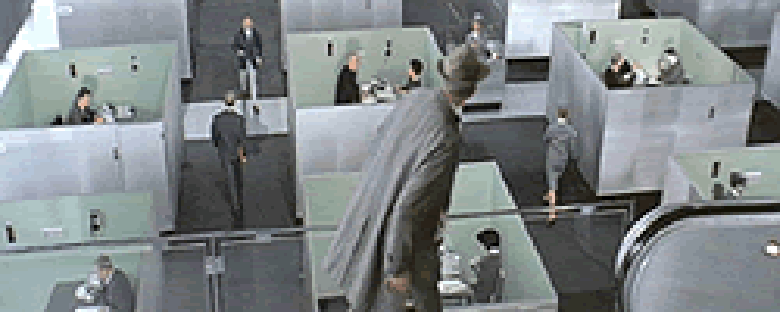Reviews
Jacques Tati
France, 1967
Credits
Review by Rumsey Taylor
Posted on 11 July 2004
Source The Criterion Collection DVD
Discordant jazz opens Jacques Tati’s Playtime, jarring against a static frame of clouds and sky. The music is a contrast to the ethereal image and becomes complementary once the frame is crowded by monochrome tableaux of metal, glass, and other commercial surfaces.
Playtime is a film of observation, a film without primary characters and without a descriptive narrative. There are essentially only three locations, inhabited successively in the film’s duration: an office tower with a symposium of inventions and gadgets, atrial apartment rooms (visible through a building’s entire wall of glass), and an overly decorated restaurant. Each is a work of totally and hilariously inefficient modern architecture, emblematic of the film’s extraordinary production design. Chairs in each location (a consistent detail) are each uniquely designed and uniquely uncomfortable.
Playtime is known foremost as a vehicle for Tati’s character Monsieur Hulot (portrayed by the filmmaker himself), seen previously in M. Hulot’s Holiday and Mon Oncle. Its predecessors routinely lauded (Mon Oncle was awarded with a Best Foreign Film Oscar and the Jury Special Prize at Cannes), Playtime failed to receive the critical success familiar to Tati, and singularly impeded his formerly prosperous career. This film (due in accordance with its very failure) is a masterpiece of post-modern cinema.
The film is an extension of the comic surveillance of M. Hulot’s Holiday and Mon Oncle, furthering — even exemplifying — Tati’s trademark commentary on the utility of commercial progress. In Mon Oncle the bourgeoisie is represented by new, clean automobiles driven on freshly paved highways. The resulting traffic is an example of conformity: each vehicle is similar to the next and is traveling in the same direction. Design and commercial improvement (a word contested in this depiction) disable the basic convenience of an automobile. This detail relays the spirit of Tati’s first three Hulot films, although the commentary is most successfully and abundantly employed in Playtime. The entire film supplies opportunities to relay this commentary; it is comprised entirely of comic episodes that intend to display an inherent lack of utility in technological advancement. Playtime’s ostensible central narrative, involving an outing in Paris for Monsieur Hulot, is incidental.
Tati’s disinterest in traditional plotting is seconded by its characterization: characters recur in the film’s periphery, each at an impersonal distance, and are differentiated by their native bicker (several languages are spoken in the film) and dress. They are distinguished by amenities and not personality. This is especially qualified by Hulot, who sports the most discernable costume in the film; contrarily, he also has the most apparent personality: awkwardly polite and innocent. In a related gesture, Hulot’s vehicle in Holiday is an extension of his unique character. It is never seen caught in traffic.
Tati’s direction, the most accomplished in his canon, is resistant and individual. His work resembles a silent film, yet was made with premium resources: 70mm film stock and four-channel quadraphonic sound (speakers positioned near each corner of the enlarged frame, allowing the sound to pan both horizontally and vertically). Such technical ambition is typically befitting of action pictures and films in exotic landscapes, and is of questionable utility here as the film so clearly varies from more customarily technologically polished pictures. The film has an active periphery and ambience. Playtime is at once a formidable success in production design, detail, framing, staging, and, not the least of its laurels, comic timing.
The success of Playtime’s technical innovation, however, is contrasted by its commercial failure. It was the most expensive French film made at its debut, repeatedly refinanced despite the film’s apparent, if not strident, anti-commercial stance. The production inevitably folded. Tati lost the rights to each of his films, and would go on to make two more films prior to his 1982 death. It was not an ironic fate, given the film’s argumentative take on commerce and material necessity. This failure is apt as it coincidentally mirrors the film’s thematic intent. It is an adamant vision whose failure is integral to its philosophy; that material devices (evaluated by their popularity) are useless. It is a befitting fate that Tati’s art was not endorsed by popularity.
The final, extended scene in the film (before its abrupt ending) involves the maiden shift at an upper-class restaurant. It is filled quickly with guests, though its popularity results in innumerable problems in the service, cooking, and presentation. Progressively, the service worsens, culminating in a destruction — everything goes wrong. This disaster, among the patrons, is a cause for celebration. The locale falls apart, and its guests remain and quickly fashion a makeshift bar. Figuratively, the invention fails, and its user maintains an ancillary interest; the music perseveres and most everyone keeps dancing. Appropriately, Playtime’s making is a similar celebration marred by calamity.
We don’t do comments anymore, but you may contact us here or find us on Twitter or Facebook.



